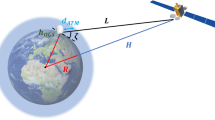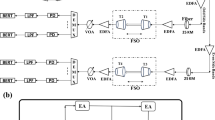Abstract
The effects of different wavelength conversion ranging configurations on the performance of Wavelength Division Multiplexing (WDM) optical switches are investigated. Any-to-Any, Any-to-Range, Range-to-Any, and Range-to-Range conversion ranging configurations are considered. These mechanisms provide important design alternatives for optical switches due to technological limitations in the implementation of full range wavelength conversion in an all-optical wavelength converter device. Limited-range wavelength converter (LRWC) is a more economical and practical solution for WDM based optical networks. Differences among the input and output side ranging mechanisms and their effects on conversion resource sharing, and consequently on performance, are investigated. Any- to-Range ranging configuration is the most efficient mechanism and it operates comparably to Any-to-Any, reducing the need for complex control algorithms. The results help determine the most efficient ranging configuration for all-optical crossconnect.
Similar content being viewed by others
References
Elmirghani J.M.H., Mouftah H.T. (2000). All-optical wavelength conversion: technologies and applications in DWDM networks. IEEE Commun. Mag. 38(3):86–92
Tripathi T., Sivarajan K.N. (2000). Computing approximate blocking probabilities in wavelength routed all-optical networks with limited range wavelength conversion. IEEE J. Select. Areas Commun. 18(10):2123–2129
Ramaswami R., Sasaki G. (1998). Multi-wavelength optical networks with limited wavelength conversion. IEEE/ACM Trans. Networking. 6(6):744–754
Xiao G., Leung Y.W. (1999). Algorithms for allocating wavelength converters in all-optical networks. IEEE/ACM Trans. Networking. 7(4):545–557
Al-Zahrani, F., Habiballa, A., Jayasumana, A.: Path blocking performance in multi-fiber wavelength routing networks with and without wavelength conversion. Proc. IEEE ICCCN ’03, pp. 580–583. Dallas, TX (October 2003)
Al-Zahrani, F., Habiballa, A., Jayasumana, A.: Performance Merits of Multi-Fiber DWDM Networks Employing Different Shared Wavelength Conversion Resources Architectures. Proc. IEEE region 5 conference ’04, pp. 59–67. Norman, OK (April 2004)
Habiballa, A., Al-Zahrani, F., Jayasumana, A.: Wavelength Conversion Resources Allocation Algorithms for Share- per-Link Wavelength Convertible Switch. Proc. IEEE region 5 conference ’04, pp. 131–139. Norman, OK (April 2004)
Yates J.M., Rumsewicz M.P. (1999). Wavelength Converters in Dynamically Reconfigurable WDM Networks. IEEE Commun. Surveys Q2:2–15
Campi D., Coriasso C. (2000). Wavelength Conversion Technologies. Photonic Network Commun. 2(1):85–95
Spiekman L., Koren U., Chien M., Miller B., Perino J. (1997). All-Optical Mach-Zehnder, Wavelength Converter with Monolithically Integrated DFB Probe Source. IEEE Photonics Technol. Lett. 9(10):1349–1351
Xu, L., Oxenlowe, L.K., Chi, N., Mork, J., Jeppesen, P., Hoppe, K., Hanberg, J.: Experimental characterisation of wavelength conversion at 40Gb/s based on electroabsorption modulators. Proc. IEEE Lasers and Electro-optics Society LEOS ’02 Annual Meeting 1, 111–112 (2002)
Lin, T., Sasaki, G.: Nonblocking WDM Networks with Fixed-Tuned Transmitters and Tunable Receivers. Proceedings of 37th Annual Allerton Conference on Communication, Control, and Computing 400–401 (1999)
Wolfson, D., Hansen, P.B., Fjelde, T., Kloch, A., Janz, C., Coquelin, A., Guillemot, I., Gaborit, F., Poingt, F., and Renaud, M.: 40Gbit/s All-Optical Wavelength Conversion in an SOA-Based Allactive Mach-Zehnder Interferometer, ECOC ’99 170–171 (1999)
Inoue K., Hasegawa T., Oda K., Toba H. (1993). Multichannel Frequency Conversion Experiment Using Fiber Four-Wave Mixing. Electron. Lett. 29(19):1708–1710
Caccioli D., Paoletti A. et al. (2004). Field Demonstration of in-Line All-Optical Wavelength Conversion in a WDM Dispersion Managed 40-Gbit/s Link. IEEE J. Selected Topics Quantum Electronics 10(2):356–362
Author information
Authors and Affiliations
Corresponding author
Rights and permissions
About this article
Cite this article
Habiballa, A.A., Al-Zahrani, F.A., Fayoumi, A.G. et al. Performance tradeoffs of optical WDM switches using different shared limited-range wavelength conversion mechanisms. Photon Netw Commun 12, 285–294 (2006). https://doi.org/10.1007/s11107-006-0023-4
Received:
Revised:
Accepted:
Published:
Issue Date:
DOI: https://doi.org/10.1007/s11107-006-0023-4




